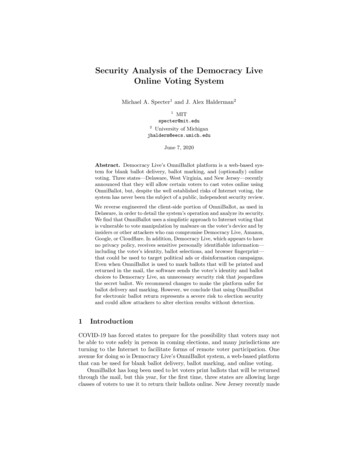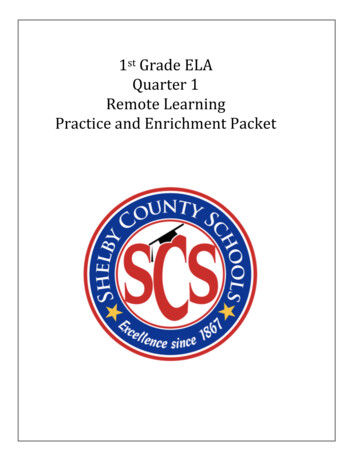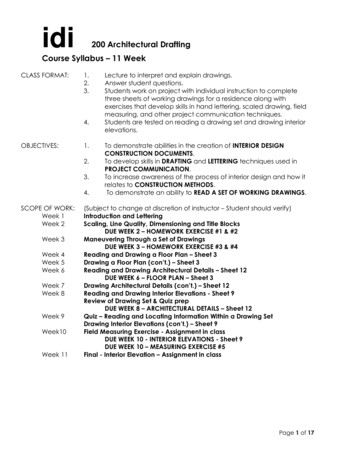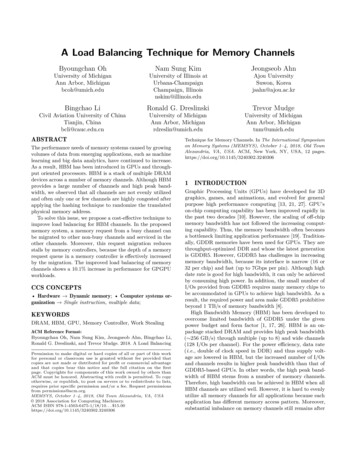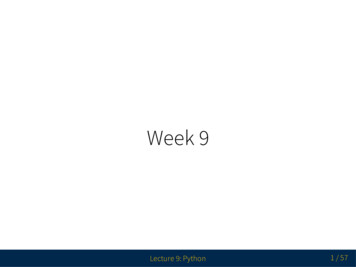
Transcription
Week 9Lecture 9: Python1 / 57
AnnouncementsBasic, Advanced 6 now due November 1Basic 8, Advanced 8 due November 10Remember about the autograder!SSH into the peritia.eecs.umich.edu serverRun eecs201-test assignment-name e.g. eecs201-test basic8Lecture 9: Python2 / 57
Lecture 9: Pythonimport tensorflow as tfLecture 9: Python3 / 57
OverviewHigh level scriptingWhat is entsModules and packages and the standard libraryPackage managersUseful tidbitsExtraDebugging, NumPy, SciPy, MatplotlibLecture 9: Python4 / 57
High level scriptingShell scripting syntax is rather unwieldyIt's oriented around organizing running utilitiesTraditional compiled high-level languages (C, C , Java, etc.) tend to have a lot ofboilerplate to deal withThey go fast thoughWhat if you want something easy and powerful but don't necessarily need blazingperformance?This is where higher level programming/scripting languages come inPython, Perl, Ruby, to name a fewTend to be interpreted, not needing compilationOften come with a lot more abstractions and expressive power than languageslike C and C This tends to come at a cost of performance, thoughWe'll be looking at Python specifically for this lectureLecture 9: Python5 / 57
What is Python?The horse's mouth:"Python is an interpreted, interactive, object-oriented programming language. Itincorporates modules, exceptions, dynamic typing, very high level dynamic data types,and classes. Python combines remarkable power with very clear syntax."I find the second statement to be very true: it's really easy to do really powerfulstuff that reads well and isn't bogged down by weird syntax (cough C cough)One of my favorite languages.coming from a person whose favorite languagesinclude C, assembly languages, and (System)VerilogLecture 9: Python6 / 57
What is Python?Currently in version 3 (version 2 is at its end-of-life)This lecture is going to focus on Python 3Has an extensive, powerful, easy to use standard libraryGreat to use when you want to do something more complicated than can be (easily)handled in a shell scriptCan be used anywhere from data processing to scientific computing to webapps (e.g.Flask) to games (Ren'Py, anyone?)I've used Python for random scripts, autograders, data processing, managing aGitLab server, prototyping a OpenCV app, and working on a (crappy) visual novelLecture 9: Python7 / 57
Running PythonThere are multiple ways to run and use PythonAs a scriptIn its interpreter's shellIn an IDE (e.g. Spyder)Your system may link/alias the python command to python2 or python3Be aware of which one it is: running python --version can help outScript files can be run via the python/python3 command or directly with a shebang(#!/usr/bin/env python3) python script.py ./script.py (after chmod)You can run the interactive shell via python/ python3Good for tinkering with some Python wizardryI'm focusing more on its use as a script, but I will use the interactive shell for somedemonstrationsLecture 9: Python8 / 57
FundamentalsYou all have learned at least one (typed) programming language by now, so I'm goingto focus on the parts that make Python "Python"This is going to skim over the basic stuff that every language has (e.g. control flow)Once you learn one language, picking up another language isn't too difficult: it'sjust learning the particular syntax and language quirksThe source of all this information is the official Python 3 documentation and its tutorialI'm not here to exhaustively just dump reference info onto you: you can easily findthe exact behavior of sequence[i:j] by perusing the documentationI'm also not here to give you a nice easy step-by-step tutorial on Python: youalready know how to write code and the tutorial above and countless others onthe internet can get you started.I'm here to highlight the key ideas and features powering Python as a means toboth expand and apply your theoretical CS knowledge(By the way, perusing the documentation is how I'm coming up with these slides)Lecture 9: Python9 / 57
A taste of Python#!/usr/bin/env python3class Foo:def init (self, str, num):self.x strself.y numdef str (self):return self.x ": " str(self.y)def fib(n):seq [0, 1]while len(seq) n:seq.append(seq[len(seq)-1] seq[len(seq)-2])return seqfibseq fib(10)bar []for n in fibseq:bar.append(Foo('fib', n))for b in bar:print(b)Lecture 9: Python10 / 57
BasicsConceptually works much like a shell script interpreterThings like functions (and classes) can be entered in manually at the shell, much likewith BashPretty much everything you can do in a script can be done manually at the shell, so ifyou wanted to play around with stuff you could do thatSemicolons not required; they can be used to put multiple statements on a single lineMeaningful whitespaceInstead of using keywords like do and done or things like curly brackets,indentations are used to mark the scope of code blocksLecture 9: Python11 / 57
Variables and DataUnderstanding how Python handles data is essential to understanding PythonInfo comes from the Data model section by the wayEvery datum is an object (this includes functions!)Every object consists of an ID, type, and valueValue also consists of attributes (i.e. member variables)The type determines mutabilityMutable objects have values that can changeImmutable objects have values that can't changeA variable is a reference to a particular objectVariables can be assigned via Assignment really mean that it becomes a reference to the RHS's objectid(var) and type(var) will return the ID and type of the object referenced byvariable varLecture 9: Python12 / 57
Playing with variables and objectsa 5 # "a" becomes a reference to an integer whose value is "5"b a # "b" becomes a reference to the object "a" refers toprint(id(a))print(id(b))print(a is b)b 7# ?print(id(b)) # ?print(a is b) # ?When we look at the built-in types we'll why this happensLecture 9: Python13 / 57
Built-in types (the important ones)Type info comes from its section in Data modelLiteral info comes from its section in Lexical Analysis for you programming languages(PL)/compilers nerdsThere's a bunch of built-in functions and operations that they can do: refer to thestandard library reference manual for details.NoneIndicates "lack" of value; analogous to nullNoneFunctions that don't return anything return NoneLecture 9: Python14 / 57
NumbersThese are immutable! A new number is a new object!Think about how this affected the behavior in the previous exampleint: represent integersLiterals: 12345, 0b01001101, 0o664, 0xbaadf00d(As of 3.6 you can also insert to group digits to make long literals more readablee.g. 0b0100 1101)bool: special integers that represent truth valuesValues can be True (1) and False (0)float: double-precision floating pointLiterals: 12345.0, 12345., 1e10, 1e-10, 1e 10complex: pair of double-precision floating point numbersreal and imag componentsImaginary literals: like regular float literals but with a j after e.g. 12345.0jLecture 9: Python15 / 57
SequencesOrdered "sets" (think "array") that are indexable via []Mutable sequencesLists (list)Sequence of arbitrary objects (like a Tuple but mutable)Created via a comma-delimited list of expressions in square brackets e.g.[1,2,3,4,5], []Byte arrays (bytearray)Sequence of 8-bit bytes (like a Bytes but mutable)Created via the bytearray() functionLecture 9: Python16 / 57
Immutable sequencesStrings (str)Sequence of Unicode code points from U 0000 - U 10FFF; this means thateach character isn't necessarily a byte!Literals: 'string contents' and "string contents"encode() can convert a string into raw bytes given an encodingBytes (bytes)Sequences of 8-bit bytes (like a Bytearray but immutable)Literal: b'some ASCII string', b"some ASCII string"decode() can convert a bytes object into a String given an encodingLecture 9: Python17 / 57
Immutable sequencesTuples (tuple)Sequence of arbitrary objects (like a List but immutable)Created via a comma-delimited list of expressions e.q. 1,2,3,4,5You can wrap it in parentheses to separate it from other stuff e.g. (1,2,3,4,5)Note that it's the commas that make tuples: there's an exception where an emptytuple is created by ()This is the magic behind the returning of "multiple objects" and "multipleassignment" e.g. a,b,c 1,2,3Lecture 9: Python18 / 57
SetsUnordered sets of unique, immutable objectsSets: mutable sets (set)Created via the set() function or comma-delimited list of expressions with curlybrackets{1, 2, 3, 4}Frozen sets: immutable sets (frozenset)Created via the frozenset() functionLecture 9: Python19 / 57
Mappings"These represent finite sets of objects indexed by arbitrary index sets"i.e. they're maps/associative arrays etc.Stores key-value pairsOnly one type (right now): Dictionaries (dict)MutableCreated via {}: e.g. { key1:value1, key2:value2 }Keys can be of any immutable, hashable typeIndexable via key: e.g. some dict[some key], another dict['stringkey']Add items by indexing via some key: e.g. some dict['hello'] 'world'will add the pair 'hello':'world' to the dictionaryLecture 9: Python20 / 57
CallablesYes, functions themselves are objects with particular typesThis means that you can easily assign variables to them!p printp('hello world!')Lecture 9: Python21 / 57
Some callable types (there's more as well)Each of these have special attributes that describe some component of it e.g.defaults , codeUser-defined functionsInstance methods (i.e. class member functions)The self attribute refers to the class instance object and gets implicitlypassed as the leftmost argumentsome instance.some func()ClassesYes, these are callable: by default they produce new object instances when calledsome instance MyClass(some arg)Lecture 9: Python22 / 57
ExpressionsThere's a lot of nitty-gritty details in the manual if you're interestedThese are units of text that resolve into some sort of valueIdentifier: varnameLiteral: 123, 'some string', b'some bytes'Enclosure: (123 23), ['i', 'am', 'a', 'list'], {1:'dict',2:'view'}Attribute reference (i.e. member access): .e.g. someobject.someattrLecture 9: Python23 / 57
ExpressionsSubscription: [ index ]Implemented by things like sequences and dictionariesSlicing: [lower:upper:stride]e.g. somelist[1:3]A selection of items in a sequenceMultiple ways to specify oneCalls: foo(arg1, arg2)For callable objects, which include functions/classesLecture 9: Python24 / 57
Operators (some can be implemented/overloaded!)Power: **2 ** 5: "2 to the power of 5"Unary: -, , -2Binary arithmetic: , -, *, /, //, %, @/ is a real division, // is a floor division (i.e. integer division)@ is intended for matrix multiplication, but no built-ins implement itBinary bitwise: &, , 0x5a5a 0xa5a5Shifting: , 1 5Lecture 9: Python25 / 57
Operators (some can be implemented/overloaded!)Comparison: , , , , , ! , is, is nota b, a is bMembership: in, not ini in [0, 1, 2, 3]Boolean: not, and, ora and b, a or b, not aConditional/ternary: x if C else y (analogous to C/C C ? x : y)If C is True, evaluates x, else evaluates yLecture 9: Python26 / 57
Comprehensions"Pythonic" way to create lists, sets, and dictionariesIterates over an iterable object allowing you to perform operationsOptional conditional to filter out certain objectsList comprehension[s.name for s in students][s.name for s in students if s.grade 70]Set comprehension{s.name[0] for s in students]}{s.name[0] for s in students if s.grade 70]}Dictionary comprehension{s.name:s.grade for s in students}{s.name:s.grade for s in students if s.name[0] 'A'}There's more to them, like multiple for and ifCheck out the tutorial and the reference manualLecture 9: Python27 / 57
Simple statements (some of them)Simple statements are statements that are on one lineYou can put multiple simple statements on one line by separating them withsemicolonsThe examples are not exhaustive: for instance, there's many different kinds ofexceptions that can be raisedExpressionsa (for some variable a)5 3foo()The object the expression resolves to will be printed out at the interactive shellLecture 9: Python28 / 57
Assignments: bind a variable to some object (or one produced by an expression)a 5b 'hello'Augmented assignments: combine binary operation and assignmenta 1assert: assertionassert a 0del: deletesCan unbinds variable(s); various classes can overload this for different behaviorsdel adel sequence[3]Lecture 9: Python29 / 57
return: leaves a function callCan just return returnCan specify an object to return return aCan return "multiple" objects inside a tuple return a,b,cpass: no-op, used where a statement is needed but you don't want to do anythingraise: raises an exceptionraise Exception("oops")break: break out of a loopcontinue: skips the rest of current iteration of a loop and go to the nextimport: imports a module; more on this laterLecture 9: Python30 / 57
Compound statementsCompound statements are called so as they group multiple statementsYou've got your standard bevy of control flow elements as well as try-catch andfunctions and classesComposed of a header (keyword and ends in colon e.g. def hello():) and a suite(the stuff "inside")The suite is a code block, which is either on the same line of the header or indented onthe following linesdef function1(arg): # this is the "header"pass # these statementspass # are in the suitedef function2(arg): pass; pass; pass; # suite on the same lineLecture 9: Python31 / 57
if-elif-elseif a b:print('a b')elif a b:print('a b')else:print('a b')Lecture 9: Python32 / 57
whilewhile a b:print(a)a - 1forIterates over an iterable object such as a sequence (e.g. list, string)list ['hello', 'world', 'foo', 'bar']for x in list:print(x)# range() is a built-in function that returns an# immutable iterable sequence of integersfor i in range(len(list)):print(list[i])Lecture 9: Python33 / 57
tryAllows you to handle exceptions and perform cleanup# a 1a 0try:b 5 // aexcept eanup.")Lecture 9: Python34 / 57
withThis one is a bit more complicated: it adds some convenience factor to try-exceptfinallyDetails in the reference manual!In short, there's special functions tied to certain objects that will automatically getcalled when exceptions get raisedYou see this a lot when opening files, where it can close files for you without yourexplicitly calling close()Lecture 9: Python35 / 57
withwith open("somefile.txt", "r") as f:data f.read()# *similar* to, not *equivalent*# the equivalent is a bit more complexhit except Falsetry:f open("somefile.txt", "r")except:hit except Truefinally:if not hit except:f.close()Lecture 9: Python36 / 57
Functions and classesThe definitions are compound statementsI put them in their own section because they also have a usage componentFunctionsFairly self explanatory, with a neat feature of optional argumentsTerminology for calling:Positional argument: "typical", specified by order of your argumentsKeyword argument: specified by the name of the argumentDefault argument: definition provides a default valueLecture 9: Python37 / 57
def func1():pass # hey, a use for pass!def func2(arg1, arg2 "default"):print(arg1 " " arg2)def func3(arg1, arg2 "default", arg3 "default"):print(arg1 " " arg2 " " arg3)func1()func2("arg1") # arg2 defaults to "default"func2("arg1", "arg2") # use of positional argumentsfunc3("arg1", arg3 "arg3") # use of keyword argumentLecture 9: Python38 / 57
ClassesAlso fairly self explanatoryClass definitions really just customize class objectsClasses have special functions that you can implement things like "constructors" anddo the equivalent of operator overloading from C Remember that classes are callable: when called they run their new() functionto make a new instance, and then by default pass the arguments to the instance'sinit()(These xxx() functions are called "dunder" methods and serve as a way toimplement underlying behavior for various things e.g. operator "overloading")Lecture 9: Python39 / 57
class Foo:# variables here are class attributes: they're analogous# to static class variables in other languagesnum foos 0# you can define functions inside of a class definition# that will become your member functions ("methods")# init () is like a constructor# The first argument is a special variable that refers to# the instance, analogous to "this" in C , but is implicitdef init (self, arg1, arg2, arg3):# this is where we set member variables of class instancesself.a arg1self.b arg2self.c arg3type(self).num foos 1def somefunc(self):return self.a self.b self.cfoo instance Foo('a', 'b', 'c')print(foo instance.somefunc())print(Foo.num foos)Lecture 9: Python40 / 57
An example of "operator overloading"class Foo:num foos 0def init (self, arg1, arg2, arg3):self.a arg1self.b arg2self.c arg3type(self).num foos 1# "overload" the operatordef add (self, other):if type(other) is Foo:return Foo(self.a other.a,self.b other.b,self.c other.c)return Nonedef somefunc(self):return self.a self.b self.cfoo1 Foo('a', 'b', 'c')foo2 Foo('d', 'e', 'f')print((foo1 foo2).somefunc())Lecture 9: Python41 / 57
Modules and packages and thestandard librarySo far we've gone over things that are built directly into the Python language itselfPython also comes with an extensive standard library that can do lots of stuff fromcommon mathematical operations to networkingThe standard library has a detailed manualDetails not just standard library stuff but also the built-in functions and operationsthat can be done on the built-in typesLecture 9: Python42 / 57
ImportingTo make use of the standard library, you'll have to import the modulesimport sys will import the sys moduleimport math will import the math moduleThis will make the things defined in the module accessible through some identifier,which by default is the module's namesys.argv accesses the script's argument list, which is under the sys moduleYou can also have import use another identifier for that moduleimport sys as s will allow you to identify the sys module as simport tensorflow as tfLecture 9: Python43 / 57
What is a module anyway?A module is a unit of Python codeA module can comprise of a single or multiple filesIn a directory with some module.py and user.py, user.py could have:import some modulesome module.cool thing()The import process will search a predefined search path and then the currentdirectoryThen what's a package?A Python package is a special kind of module that has a sort of hierarchy ofsubpackages e.g. email.mime.text, where email is a package that has asubpackage mimeLecture 9: Python44 / 57
Package managersYou're not restricted to just the standard library and your own modulesYou can also install modules and packages used by other peopleNumPy, Matplotlib, SciPy, OpenCV to name a fewThe two most common ones are pip and conda (associated with the Anacondadistribution of Python)Sometimes a particular Linux distribution's package manager will also managePython packages e.g. pacmanLecture 9: Python45 / 57
Useful tidbitsLecture 9: Python46 / 57
Built-insI/Oprint()open()Typeslen(sequence) will get the length of a sequencestr(obj) to get a string representation of an objectint(obj) produce an integer from a string or other numberlist.append() (and its friends) to manipulate listsrange() to produce a range object, which is an immutable sequence of numbersUseful for for loopsdict.values() provides an iterable object with the values of a dict (dictionary)Lecture 9: Python47 / 57
Standard library modulessys, os, io, math, statistics, copy, csv, reA lot of the other ones are application dependentLecture 9: Python48 / 57
Library functions and attributessys.argv: list of command-line argumentsos.system("ls -a"): run a shell commandsubprocess.run(['ls', '-l'],capture output True).stdout.decode('utf-8'):run a shell command, get its output, decode to string via UTF-8copy.copy(): perform a shallow copy of an objectcopy.deepcopy(): perform a deep copy of an objectmath.ceil(), math.floor()read(), write(), close()Depending on how you open() a file, you'll get different file object types (e.g. textvs binary) with different attributesLecture 9: Python49 / 57
Looking back at our taste of Python#!/usr/bin/env python3class Foo:def init (self, str, num):self.x strself.y numdef str (self):return self.x ": " str(self.y)def fib(n):seq [0, 1]while len(seq) n:seq.append(seq[len(seq)-1] seq[len(seq)-2])return seqfibseq fib(10)bar []for n in fibseq:bar.append(Foo('fib', n))for b in bar:print(b)Lecture 9: Python50 / 57
ExtraA bit out of the scope of this one lecture, but usefulthings to look atPerhaps these will be advanced exercises Lecture 9: Python51 / 57
Debugging with pdbStandard library module that provides debugging supportReference manual entryLecture 9: Python52 / 57
NumPyPackage that provides fundamental types and operations for scientific applicationsWell known for its array typeAlso has useful functions such as FFTsThese are optimized for performance!NumPy arrays serve as one of the backbones of Python-based scientificcomputationUser guideLecture 9: Python53 / 57
SciPyPackage that provides functions and algorithms for scientific computationLinear algebra, FFTs, stats etc.RefenceLecture 9: Python54 / 57
MatplotlibPackage that provides visualization functions for making graphs and stuffUser guideLecture 9: Python55 / 57
With NumPy, and SciPy, Matplotlib, who needsMATLAB?Not a fan of it as a language (also ), but its libraries and utilities areLecture 9: Python56 / 57
Questions?Lecture 9: Python57 / 57
Reference manual entry Lecture 9: Python 52 / 57. NumPy Package that provides fundamental types and operations for scientific applications Well known for its array type Also has useful functions such as FFTs These are optimized for performance! NumPy arrays serve as one of



